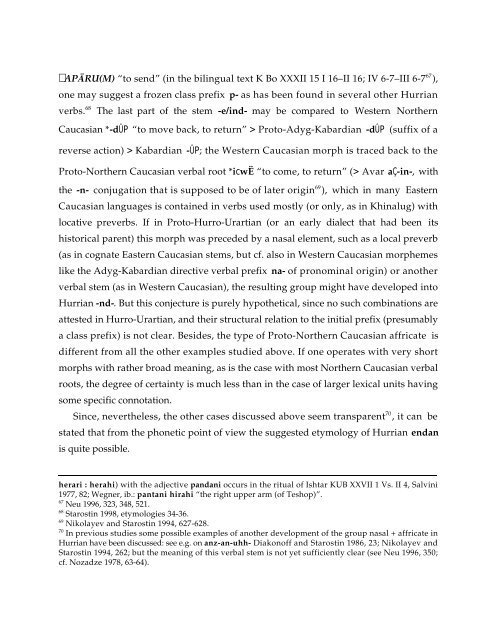Comparative Notes on Hurro-Urartian, Northern Caucasian
Comparative Notes on Hurro-Urartian, Northern Caucasian
Comparative Notes on Hurro-Urartian, Northern Caucasian
Create successful ePaper yourself
Turn your PDF publications into a flip-book with our unique Google optimized e-Paper software.
AP RU(M) “to send” (in the bilingual text K Bo XXXII 15 I 16–II 16; IV 6-7–III 6-7 67 ),<br />
<strong>on</strong>e may suggest a frozen class prefix p- as has been found in several other Hurrian<br />
verbs. 68 The last part of the stem -e/ind- may be compared to Western <strong>Northern</strong><br />
<strong>Caucasian</strong> *-dÛP “to move back, to return” > Proto-Adyg-Kabardian -dÛP (suffix of a<br />
reverse acti<strong>on</strong>) > Kabardian -ÛP; the Western <strong>Caucasian</strong> morph is traced back to the<br />
Proto-<strong>Northern</strong> <strong>Caucasian</strong> verbal root *ićwË “to come, to return” (> Avar aÇ-in-, with<br />
the -n- c<strong>on</strong>jugati<strong>on</strong> that is supposed to be of later origin 69 ), which in many Eastern<br />
<strong>Caucasian</strong> languages is c<strong>on</strong>tained in verbs used mostly (or <strong>on</strong>ly, as in Khinalug) with<br />
locative preverbs. If in Proto-<strong>Hurro</strong>-<strong>Urartian</strong> (or an early dialect that had been its<br />
historical parent) this morph was preceded by a nasal element, such as a local preverb<br />
(as in cognate Eastern <strong>Caucasian</strong> stems, but cf. also in Western <strong>Caucasian</strong> morphemes<br />
like the Adyg-Kabardian directive verbal prefix na- of pr<strong>on</strong>ominal origin) or another<br />
verbal stem (as in Western <strong>Caucasian</strong>), the resulting group might have developed into<br />
Hurrian -nd-. But this c<strong>on</strong>jecture is purely hypothetical, since no such combinati<strong>on</strong>s are<br />
attested in <strong>Hurro</strong>-<strong>Urartian</strong>, and their structural relati<strong>on</strong> to the initial prefix (presumably<br />
a class prefix) is not clear. Besides, the type of Proto-<strong>Northern</strong> <strong>Caucasian</strong> affricate is<br />
different from all the other examples studied above. If <strong>on</strong>e operates with very short<br />
morphs with rather broad meaning, as is the case with most <strong>Northern</strong> <strong>Caucasian</strong> verbal<br />
roots, the degree of certainty is much less than in the case of larger lexical units having<br />
some specific c<strong>on</strong>notati<strong>on</strong>.<br />
Since, nevertheless, the other cases discussed above seem transparent 70 , it can be<br />
stated that from the ph<strong>on</strong>etic point of view the suggested etymology of Hurrian endan<br />
is quite possible.<br />
herari : herahi) with the adjective pandani occurs in the ritual of Ishtar KUB XXVII 1 Vs. II 4, Salvini<br />
1977, 82; Wegner, ib.: pantani hirahi “the right upper arm (of Teshop)”.<br />
67 Neu 1996, 323, 348, 521.<br />
68 Starostin 1998, etymologies 34-36.<br />
69 Nikolayev and Starostin 1994, 627-628.<br />
70 In previous studies some possible examples of another development of the group nasal + affricate in<br />
Hurrian have been discussed: see e.g. <strong>on</strong> anz-an-uhh- Diak<strong>on</strong>off and Starostin 1986, 23; Nikolayev and<br />
Starostin 1994, 262; but the meaning of this verbal stem is not yet sufficiently clear (see Neu 1996, 350;<br />
cf. Nozadze 1978, 63-64).





